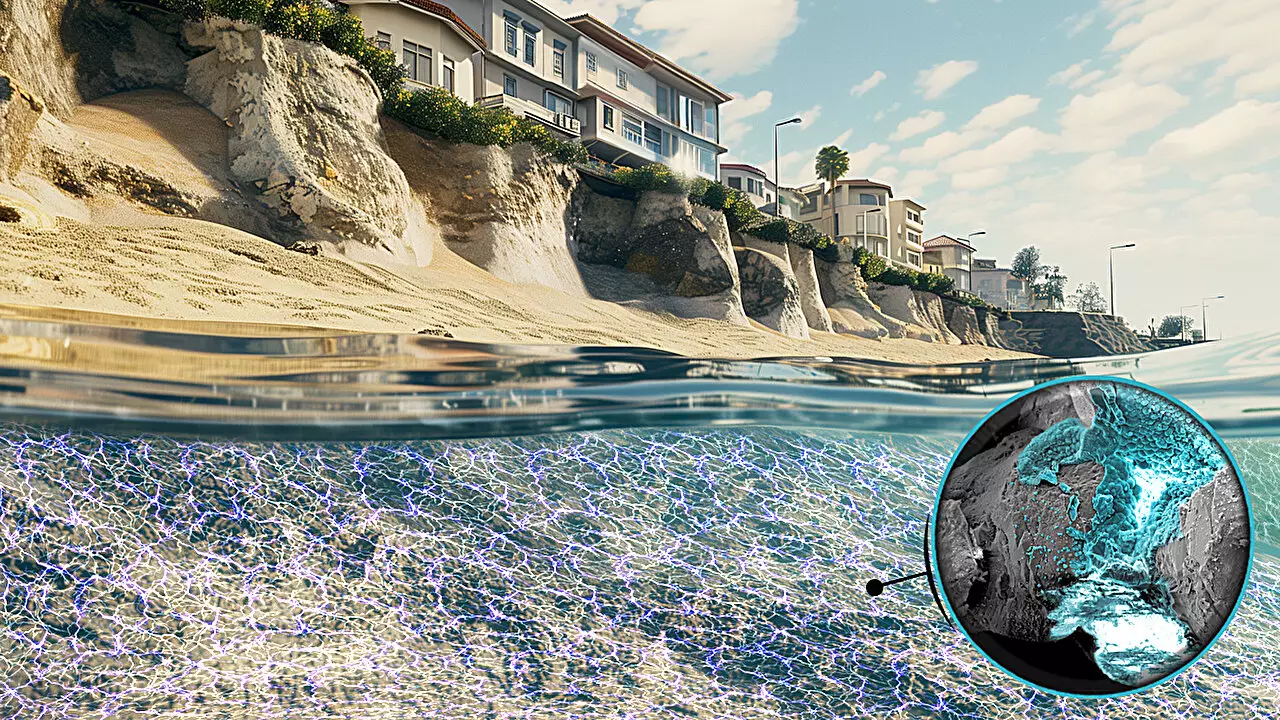As climate change accelerates, coastal communities face an existential threat from rising sea levels and increasing erosion. Roughly 26% of the world’s beaches could vanish by the century’s end, according to research by the European Commission’s Joint Research Centre. With over 40% of the global population residing in coastal regions, the urgency to find effective and sustainable solutions to coastal erosion has never been more critical.
Efforts to combat erosion have typically involved the construction of barriers such as sea walls or methods that inject cement into sandy substrates. However, these traditional strategies are not only expensive; they also contribute to environmental degradation and often fail to deliver long-term resilience. A recent pioneering study from Northwestern University presents an innovative alternative—using mild electrical currents to strengthen coastal sediments through natural mineral binding, potentially paving the way for a revolutionary approach to coastal protection.
The researchers studied marine life, particularly the skeletal structures of mollusks, to devise this groundbreaking technique. Mollusks use dissolved minerals from seawater to create their shells—a process reliant on metabolic energy. However, the Northwestern team ingeniously replaced biological energy with electrical energy, harnessing a naturally occurring phenomenon.
By applying a mild electrical current to marine sand, researchers activated chemical reactions that led to the formation of calcareous cement from seawater-derived minerals. This creative method effectively transforms loose sand into a solid, rock-like structure—offering a sustainable alternative to conventional erosion control.
The heart of this innovative research lies in its simplicity and effectiveness. When an electrical current of just 2 to 4 volts is introduced into seawater-saturated sand, it triggers a reaction that converts ions and dissolved minerals into robust binders like calcium carbonate and magnesium hydroxide. These minerals form a cohesive matrix, binding sand grains together more effectively than traditional cement.
This approach revolutionizes coastal engineering not just in philosophy but also in application. In laboratory settings, varying types of sand—including silica and iron sands—were successfully treated, resulting in a significant enhancement of structural integrity. In essence, the treated sand appears and acts like rock, thereby providing the much-needed strength and cohesion capable of withstanding environmental stresses over extended periods.
The implications of this research extend far beyond mere erosion control. According to Alessandro Rotta Loria, the lead scientist of the study, the versatility of this electrified cementing method opens numerous avenues for application. From strengthening marine foundations and stabilizing soil slopes to reinforcing existing shore infrastructure, the potential uses are vast.
Moreover, the technique is environmentally friendly and poses minimal risk to marine ecosystems. The voltages utilized are too low to negatively impact local aquatic life, standing in stark contrast to traditional remediation methods that often pose inadvertent threats to biodiversity.
Additionally, the process is reversible. If a community decides against retaining the solidified sand, the action of switching the electrical current can dissolve the minerals, allowing for flexibility and adaptability in coastal management.
Cost is often a crucial factor in the selection of environmental protection strategies. The Northwestern University researchers estimated that their electrical cementation process costs between $3 and $6 per cubic meter—a stark contrast to traditional methods that can skyrocket to $70 for comparable volume. This cost-effectiveness could make a huge difference for cash-strapped coastal communities seeking practical and long-lasting solutions to combat erosion without excessive financial burden.
Moreover, the same process has shown potential in repairing existing structures made of reinforced concrete that have suffered from crack-related degradation due to increasing environmental pressures. Instead of extensive and costly reconstruction, just a single pulse of electricity could significantly enhance durability.
With plans to take the research from the lab to real-world applications on beaches, the Northwestern University team is poised to change the coastal protection landscape. By leveraging the power of electrical engineering and the wisdom of nature, they are not only addressing the immediate needs of today’s coastal communities but also paving the way for a more resilient future against the ravages of climate change.
As the threat of erosion looms larger due to ongoing environmental changes, innovative solutions such as this electrification method represent a beacon of hope—a sustainable, efficient, and effective means to protect our invaluable coastal ecosystems for generations to come.


Leave a Reply